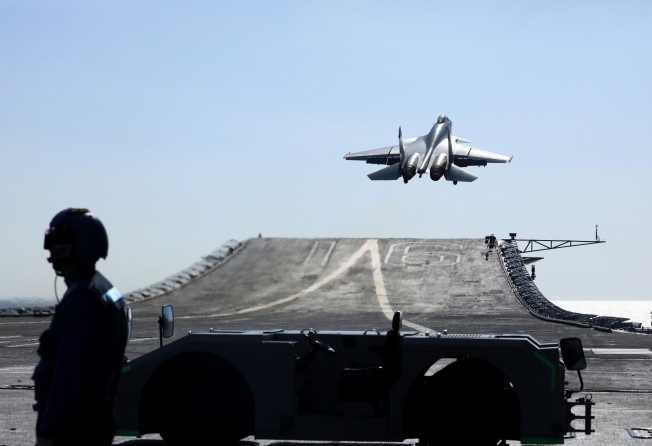
China looks to hypersonic ski-jump technology for space travel
- An obsolete way to launch jets from aircraft carriers could hold the key to affordable transport beyond Earth’s atmosphere
- Chinese scientists declare early success in scale model test at Mach 7, but further experiments will be needed

Chinese researchers say they have repurposed the traditional ski-jump method of launching a plane at sea for the hypersonic age, aiming to develop it for easier, safer space travel.
Wang Yunpeng, an associate professor with the Chinese Academy of Sciences’ Institute of Mechanics in Beijing, and his team used scaled-down versions of an orbital plane – similar to the space shuttle – and a hypersonic carrier to test the method at seven times the speed of sound.
In a paper published in peer-reviewed journal Acta Aeronautica et Astronautica Sinica on December 8, the researchers said the results proved ski-jump technology – regarded as obsolete in modern aircraft carriers – could be adapted for orbital launches from near space.
It could also solve a problem that has troubled hypersonic researchers for decades – how to overcome the strong, unpredictable turbulence generated at extremely high speeds and achieve a smooth separation between the carrier platform and the shuttle.
So far, there has been no way to effectively eliminate the risk of the separating vehicles veering off course or even colliding.
The researchers launched a 1/80 scale plane from a metre-long (three feet) model carrier using a piston to simulate rocket engine ignition as China’s JF-12 wind tunnel powered to Mach 7. In a split second, the plane shot off the top of the carrier and, as the tunnel powered down, it dropped to the floor and broke into several pieces.
According to Wang’s team, this brief and expensive experiment “verified the feasibility and effectiveness of the active separation method”.
The JF-12, one of the world’s most powerful wind tunnels, simulates the extremely hot airflow at hypervelocity with shock waves produced by a chemical explosion. While it authentically replicates the extreme conditions of hypersonic flight, the conditions can only be maintained for one second.
It was enough time to confirm that, compared with standard separation procedures, the modified ski-jump design eliminated the gap between the two plane bodies and reduced the risk of collision to a minimum, the researchers said.
In traditional aircraft carriers, the ski-jump acts as a short runway for aircraft, giving them just enough lift to leave the deck under their own power, while the carrier is running against the wind at full speed – about 60km/h (37mph).
For the hypersonic version, the researchers flattened the slightly upwards tilt of the ski-jump to create a perfectly flat surface, to reduce the drag which can occur when two vehicles separate at extremely high speed in the atmosphere.
During the wind tunnel experiment, the team observed that the plane nosed up slightly when it reached the end of the flat runway, thanks to an upwards nudge from the shock waves produced beneath the space plane’s upper front section.
But as the plane was about to leave the carrier platform, another group of shock waves formed near the tail, causing it to nose down. The two opposing forces cancelled each other out, resulting in a smooth, perfectly straight separation, the researchers said.
Wang’s team connected a powerful, gas-driven piston to the rear of the test plane to achieve take-off within the experiment’s brief time frame.

They also built an automated system to coordinate the operation of everything from the experiment’s mechanical devices to the high-speed cameras which captured the separation in vivid detail.
Wang said a full-sized upper stage space plane weighing 87 tonnes – about the same as a space shuttle – would achieve take-off in about eight seconds, powered by rocket engines, with the largest generating 1,500 kilonewtons of force. The ski-jump would use less than a tenth of the main engine’s thrust, he said.
The shock tunnel results needed to be combined with other experiments with longer testing times before the technology would be ready to leave the laboratory, the researchers said.
China plans to build a civil hypersonic fleet to transport passengers anywhere on the planet within an hour or two. In development is an air-breathing hypersonic aircraft that will be able to fly in near-space altitudes at five times the speed of sound or more.
Some scientists believe the technology will trigger a transport revolution, with the aircraft able to take off and land at existing airports, at a fraction of the cost to operate a rocket.
It will also be capable of acting as a two-stage-to-orbit launch platform for rocket-powered space planes that will take tens of thousands of passengers beyond Earth’s atmosphere each year, according to the Chinese government.